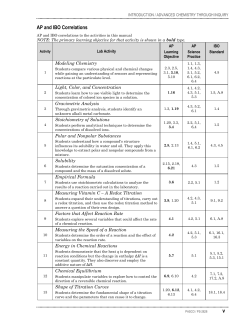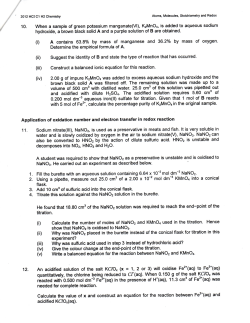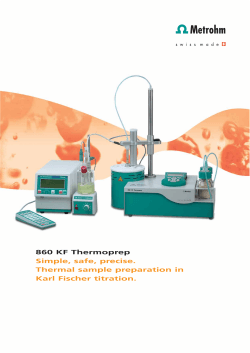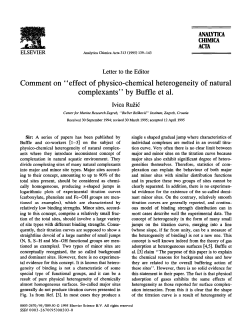
2001: SURFACE CHARACTERIZATIONOF PAN BASED
SURFACE CHARACTERIZATION OF A POLYACRYLONITRILE BASED ACTIVATED CARBON AND THE EFFECT OF pH ON ITS ADSORPTION FROM AQUEOUS PHENOL AND 2,3,4-TRICHLOROPHENOL SOLUTION Krisztina László, Etelka Tombácz*, Katalin Josepovits**, Péter Kerepesi Department of Physical Chemistry, Budapest University of Technology and Economics H-1521 Budapest, Hungary * Department of Colloid Chemistry, Szeged University Aradi vértanúk tere1, H-6720 Szeged, Hungary ** Department of Atomic Physics, Budapest University of Technology and Economics H-1521 Budapest, Hungary Experimental The granular activated carbon (APAN) used in this work was prepared from PAN by a two-step physical activation process. The preparation and the physical properties of this carbon, including the analysis of nitrogen adsorption and small angle X-ray scattering data were reported earlier [1 – 3]. This carbon is highly microporous, the BET surface area is 544 m2/g and Vtot = 0,278 cm3/g. The nitrogen 200 180 160 140 120 3 Activated carbons have been widely used as adsorbents in municipal water supply and environmental control, due to their outstanding adsorption capacity derived from the high surface area, tailor made pore structure and surface chemistry. The latter traces back to the presence of hetero atoms, such as oxygen, nitrogen, hydrogen, phosphorus, sulfur, etc. The amount and the chemical forms of these hetero atoms depend on the origin of carbon and the history of its preparation and treatment conditions. The microporous activated carbon studied in this paper was prepared from polyacrylonitrile (PAN) by the two-step physical activation method [1]. It contains both oxygen and nitrogen surface functionalities. These groups and the delocalized electrons of the graphitic structure determine the apparent acid/base character of the activated carbon surface In aqueous solutions for the presence of these acidic and basic functional groups, the surface properties of carbons depend on the pH. Thus, the distribution of surface functionalities is fundamental in activated carbon based water treatment processes. The objective of the present study is to characterize the surface properties of the activated carbon prepared from PAN and describe its adsorption from aqueous phenol solutions. Phenol and one of the potential chlorinated products, 2,3,4-trichlorophenol have been applied as model pollutants in unbuffered, acidic (pH = 3) and basic (pH = 11) aqueous solutions. adsorption isotherm (measured and evaluated using a Quantachrome Autosorb-1 computer controlled apparatus) is shown in Fig. 1. Aqueous treatment with distilled water in a Soxhlet apparatus reduced the surface area to 364 m2/g. adsorbed nitrogen, cm /g (STP) Introduction 100 80 60 40 20 0 0.0 0.2 0.4 0.6 0.8 1.0 p/p0 Figure 1. Nitrogen adsorption isotherm of APAN carbon The surface chemical composition of the samples was determined by XPS (X-ray Photoelectron Spectroscopy) using an XR3E2 (VG Microtech) twin anode X-ray source and a Clam2 hemispherical electron energy analyzer. High resolution spectra of the O1s and C1s signals were recorded in 0.05 eV steps with a pass energy of 20 eV. After the linear base line was subtracted, the curve fitting was performed assuming a Gaussian peak shape. The XPS results were published recently [2], therefore only selected data are reported here in Table 2. Characterization of acid - base properties The Boehm titration method was used to determine the number of the surface groups of the granular carbon [4]. 0.35 HCl 0.25 ∆ nσ H+ - ∆ nσ OH- , m m ol/g 0.15 0.05 2 4 6 8 10 -0.05 12 NaHCO3 (1) (2) (3) (4) (5) (6) (7) (8) (9) -0.15 -0.25 pH Na2CO3 Boehm method 0.01 M up to pH~12 (as received) 0.01 M dow n to pH~3 (as received) 1 M up to pH~11 (w ashed) 1 M dow n to pH~3 (w ashed) 1 M up again to pH~11 (w ashed) 1 M up to pH~10 (w ashed) 1 M dow n to pH~3 (w ashed) 1 M up again to pH~10 (w ashed) NaOH -0.35 Figure 2. Acid-base titration curves of the granular carbon Electrolyte 0.25 1M 0.2 0.01 M 0.15 ∆ nσ H+ - ∆ nσ OH- , m m ol/g (1) (2) (3) (4) (5) (6) (7) (8) (9) 0.1 M 0.01 M up to pH~10 0.01 M dow n to pH~3 0.01 M up again to pH~10 0.1 M up to pH~10 0.1 M dow n to pH~3 0.1 M up again to pH~10 1 M up to pH~10 1 M dow n to pH~3 1 M up again to pH~10 0.1 0.05 0 2 3 4 5 6 7 8 9 -0.05 -0.1 Figure 3. Acid-base titration curves of the powdered carbon 10 pH 11 Table 1. Results of the Boehm titration, µequiv/g Sample APAN pKa < 6.37 6.37 < pKa < 10.25 10.25 < pKa < 15.74 Total acidic 30.1 12.3 Results are collected in Table 1. The PZC = 8.4 was determined by the pH drift method [7]. A continuous potentiometric titration over the pH range between 3 and 11 were applied to study the acid-base properties of the microporous activated carbon. The equilibrium of acid-base consumption at each point of continuous titration was controlled by a criterion for pH settling (0.0005 pH/sec). Details of equilibrium acid-base titration for surface charge characterization of amphoteric solid particles are given elsewhere [9]. The reversibility of the titration was tested in a cycle of forward and backward titrations starting at the initial pH of the carbon suspension (pH ~7 to ~8.4 depending on the preparation of carbon suspension), going up to pH 10 or 11, then down to pH 3, and finally again to the upper limit of the pH chosen in the given titration. Besides providing CO2-free condition during the titration, the preparation of carbon suspension seemed to be a crucial step. Three processes were applied. #1: the as-received carbon samples were immersed into the aqueous electrolyte solution and ultrasonicated for 15 min, then stirred and bubbled with purified nitrogen for an hour. #”: the granular carbon sample was exhaustedly washed with hot water (Millipore) in Soxhlet apparatus during 72 hours and stored as suspension under nitrogen. #3: the carbon sample obtained according to #2 was ground down to fine powder. The electrolyte concentration in the suspensions of the washed and powdered samples was adjusted to 0.01, 0.1 and 1 M, respectively, then suspensions were stirred and bubbled with purified nitrogen for an hour before running the titration cycle. Suspensions were titrated with standard base and acid solutions. Titration cycles run during 6 - 8 hours depending on the samples and solution conditions. The hydrogen ion activity vs. concentration relationship was determined from a background electrolyte solution titration, so that the electrode output could be converted directly to hydrogen ion concentration instead of activity. The specific net proton surface excess amount ( ∆nσ, mmol/g), i.e. the difference between the surface excess amounts of H+ ( nσH+) and OH-( nσOH-) was derived directly from the initial and equilibrium concentrations of the solute [10]. The values of nσH+ and nσOH- were calculated in each point of the titration, and ∆nσ = nσH+ - nσOH- was plotted as a function of the equilibrium pH. 70.5 112.9 Total basic 336.3 Sorption from dilute aqueous solutions of phenols Solutions of phenol and 2,3,4-trichlorophenol were prepared using bidistilled water, or the appropriate buffer solutions (Titrisol pH = 3, and Titrisol pH = 11, Merck). 0.05 g carbon was shaken with 5 - 60 ml of phenol (5 mmol/l) or 2,3,4-trichlorophenol (2 mmol/l) solutions for 24 hrs and 7 days, respectively, in sealed vials at ambient temperature. The contact times employed were derived from preliminary kinetic measurements [5]. Initial and equilibrium concentrations were determined by detecting the UV absorption of the phenol (λ = 265 nm) and 2,3,4trichlorophenol (λ = 290 nm). Results and Discussion The original granular carbon sample was titrated under different conditions, the upper limit of titration cycle was varied and the reversibility of forward and backward titrations was tested. The proton binding isotherms, calculated from the material balance of H+/OH-, together with the results of Boehm titration (symbol 1) are shown in Fig. 2. Positive values indicate acid consumption, i.e. proton binding in the carbon suspension, while the negative ones correspond to base consumption, i.e. release of protons or binding of hydroxyl-ions. The Boehm results obtained on granular samples after a 72-hr contact time are comparable to those derived from the continuous titrations. The curves in Fig. 2 provide obvious evidence for the variety of apparent acidbase behavior of the granular sample. The proton binding isotherms determined in the direction of decreasing pH are waved, especially those run from higher pH. Definite inflections at different pH values appear on the forward and backward curves, which seem to be more characteristic of sample preparation and titration conditions than that of the sample itself. For example, H+ adsorption isotherm of the as-received sample (symbol 3: closed circle and thin line in Fig. 2) shows a sharp inflection at pH~6, while the curves of washed samples (symbols 5 and 8: closed square and triangle, unbroken and broken thick lines) have also inflections, but these are less sharp and appear at different pH values. It can be concluded that the definite inflection at pH~6 origins from some impurities of the as-received carbon sample which can be removed in the washing process. The further, less pronounced inflections of the proton adsorption isotherms are not characteristic to the carbon surface, since these shift randomly under changing solution conditions. Therefore, these have not to be identified as surface reactions taking place with definite functional groups of the carbon matrix. The most conspicuous feature of the curves in Fig. 2 is the existence of the wide hysteresis loops. Each titration cycle of the granular carbon sample shows that acid-base processes taking place in the direction of increasing and decreasing pH are not reversible, since the upward and downward curves run far from each other. Similar hysteresis loops were measured in many cases when the titration of the granular sample was performed at different ionic strengths and over various pH ranges (curves are not shown here). In every cases the H+ adsorption curves (decreasing pH due to acid addition) run significantly below the H+ desorption curves (increasing pH due to base addition), but a definite ionic strength dependence has never appeared. A general trend, i.e., the larger the hysteresis is, the higher the upper limit of pH range is over which titration was performed, can be seen on the alkaline side of the isotherms (negative net proton excess in Fig. 2). In the presented cases, the titration up to pH~10 is almost reversible, while the one up to pH~11 has a definite loop, and a huge hysteresis appears, when the upper limit of pH was as high as ~12. During the last step of the titration cycle (upward titration starting from pH~3) the desorption of the bound H+-ions (the uppermost H+ desorption curves in Fig.2) is promoted by the addition of base titrant, since neutralization reaction takes place (H+ + OH- = H2O). However, this process seems to be hindered. As the carbon is microporous (Fig. 1), a hindered diffusion of the reactant OH-ions was assumed in the micropores of the granular sample. To reduce the diffusion hindrance, a finely powdered sample was used in the further studies. The proton binding curves obtained on the powdered carbon are showed in Fig. 3 at different ionic strengths. Comparing the corresponding curves of Figs. 2 and 3, respectively, it is remarkable, that waves and inflections disappear, and the significant parts of the proton binding isotherms become straight. Although hysteresis loops are still present, i.e. the reversibility criteria of surface charge titration has not fulfilled yet, the proton binding curves at different electrolyte concentrations become comparable. It is obvious that the curves of titration cycles starting from the initial pH of carbon suspensions and ending at pH~10 (thin lines in Fig 3, i.e., symbols 1, 3, 4, 6, 7, 9), run together, i.e. they do not depend on the electrolyte concentration. The downward curves (thick lines in Fig. 3, i.e., symbols 2, 5, 8), however, below pH~8 are almost linear and their slope increases as the ionic strength is increased. This definite effect of electrolytes means that the proton binding process is enhanced by increasing salt concentration This kind of enhancement is significant in the case of surface charging. For the formed charges are located on the solid surface, a local electrostatic field develops in which the surface charges have to be compensated by the ionic cloud of electrolytes [11]. This is the charge screening effect of electrolytes. Therefore, more and more charges can develop on the surface with increasing salt concentration due to the surface protolytic reactions. Surface charging process can be assumed only if this characteristic ionic strength dependence is experienced. If there is no ionic strength dependence, the acid-base consumption originates from other reactions, such as reaction with acidic or alkaline impurities or dissolution of the solid matrix [9]. The ionic strength dependent acid-base behavior of the powdered carbon sample shows that acid-base reactions resulting in surface charge formation take place only below pH~8. Above pH~8 the acid-base consumption should be identified with reactions in which surface charges do not develop. According to a recent paper [6] slow hydrolysis of surface esters and/or lactones takes place in the alkaline region. Hydrolysis of esters and/or lactones is a probable process in our case, too. Considering the experimental condition of the continuous titration, the supposed hydrolysis can not be reversible. The small, ionic strength independent hysteresis loops in Fig. 3 above pH~8 support this hypothesis. Table 2. Selected results of the XPS analysis (atomic %) a) C1s spectra Sample I* II* III* IV* V* APAN 50.4 22.3 7.9 5.5 3.4 * I: graphitic carbon, II: hydroxyl or ether, III: carbonyl, IV: carboxyl or ester, V: shake-up satellite peaks due to π-π* transitions in aromatic rings b) O1s spectra Sample I* II* III* APAN 1.2 2.8 1.3 *I: C=O, II: carbonyl oxygen atoms in esters, amides, carboxylic anhydrides and oxygen atoms in hydroxyls or ethers, III: oxygen atoms in carboxyl groups c) N1s spectra Sample I* II* III* IV* APAN 1.7 1.8 1.3 0.5 *I: pyridine-like structures, II: pyrrolic and/or pyridon-N, III quaternary N, IV: N-oxide Table 3. Adsorption parameters of aqueous phenol and 2,3,4-trichlorophenol solutions on APAN carbon derived by the Langmuir model* Phenol pH = 3 Unbuffered pH = 11 pH = 3 nm [mmol/g] 0.78 0.78 0.72 0.99 0.96 0.63 K [dm3/mmol] 0.66 7.54 5.00 26.01 131.57 11.18 0,77 0,77 0,83 0,61 0,63 0,95 surface area available for one adsorbate molecule, nm2 a Cross sectional area nm2/molecule [8] * na = 2,3,4 - Trichlorophenol 0.30 – 0.52 Unbuffered pH = 11 0.63 – 0.72 K ×n m ×ce , where nm is the monolayer capacity, K is the adsorption equilibrium constant, na is 1+ K ×ce the adsorbed amount at a given equilibrium concentration (ce). a calculated as aS,BET , applying the corresponding unit conversions; NA is the Avogadro's number nm × NA The surface charging reactions below pH~8 can be attributed to any kind of surface protonation reaction or H+ adsorption process. According to the XPS analysis (Table 2), several forms of nitrogen (e.g. quaternary nitrogen, pyrrolic-N, pyridinic-N) exist on the surface of this carbon sample. These sites reveal a basic character and their protonation results in the formation of positive charge: C-N + H+ ⇔ C-NH+, where C-N is the surface nitrogen species. As the graphitic part of the surface is significant, the π electrons of the graphite planes are of great importance. They may act as Lewis basic sites accepting protons [12], according to the following equation: Cπ + 2H2O ⇔ CπH3O+ + OHThese active sites are randomly distributed on the carbon surface, and mutually influence each other. For example, the electron localizing effect of the hetero atomic functional groups may considerably decrease the basic strength of the π electrons. The proton transfer reactions may be accompanied by a simultaneous redox transformation [12]. Strong adsorption of H+ ions may be part of the process of reduction of water by graphitized carbon and partial oxidation of the solid [13]. Several types of individual surface sites or functional groups have been identified by XPS analysis, which are present on the carbon surface also in aqueous medium. Identification of the individual surface functionalities, however, is not possible in the surface charge titration, if the different types of sites are mixed in a random way: the surface takes on a uniform charge representing the composite charge of the individual components [14]. Sorption from dilute aqueous solutions of phenols The phenol adsorption isotherms shown in Figs. 4 and 5 belong to Type L according to Giles’ classification [45], except for the unbuffered 2,3,4-trichlorophenol curve (Htype). The adsorption capacity and the K value derived from the Langmuir fit depends on the pH (Table 3). It can be attributed to the acid – base character of the carbon discussed above and the acidic character of the adsorbate molecules. Phenol and 2,3,4-trichlorophenol are weak acid (pKa values are 9.89 and 7.59, respectively.) There is no significant difference in the monolayer capacities at various pH values, when phenol adsorbs, however, the different K values indicate different adsorption mechanism. In the case of trichlorophenol at pH = 11 only two third of the adsorption capacity was achieved and the K values show a sequence of pH = 11 < pH = 3 < unbuffered. The significant difference between the K values of the adsorbates traces back to their different solubility in water [8]. In the case of the phenol the calculated surface available for one single molecule significantly exceeds the theoretical value at any pH studied. The theoretical value was reached in the case of the trichlorophenol except pH = 11. 1.1 1.0 0.9 adsorbed phenol, mmol/g 0.8 0.7 0.6 0.5 0.4 0.3 0.2 pH = 3 unbuffered pH = 11 0.1 0.0 0.0 0.5 1.0 1.5 2.0 equilibrium concentration, mmol/dm 2.5 3.0 3.5 3 Figure 4 Adsorption isotherms (ambient temperature) from aqueous phenol solutions of various pH. Symbols are the measured values, the solid lines were fitted by the Langmuir equation. 1.1 adsorbed 2,3,4-trichlorophenol, mmol/g 1.0 0.9 0.8 0.7 0.6 0.5 0.4 0.3 0.2 pH = 3 unbuffered pH = 11 0.1 0.0 0.0 0.5 1.0 equilibrium concentration, mmol/dm 1.5 2.0 3 Figure 5 Adsorption isotherms (ambient temperature) from aqueous 2,3,4-trichlorophenol solutions of various pH. Symbols are the measured values, the solid lines were fitted by the Langmuir equation. The possible interaction between the carbon surface and phenols is a) dispersion effect between the aromatic ring and the π electrons of the graphitic structure; b) electron donor – acceptor interaction between the aromatic ring and the basic surface sites; c) electrostatic attraction and repulsion when ions are present. At pH = 3 both the functional groups on the carbon surface and the phenolic compounds are in non-ionized form, that is, the surface groups are either neutral or positively charged. As it can be deduced from the K values, the interaction between the carbon surface and the phenol is the weakest in this case and can be attributed to dispersion effect. The enhanced interaction in the case of the trichlorophenol adsorbate is due to the electron withdrawing phenomenon of the three chlorine substituents. The weak interaction in the case of the phenol results in the competitive adsorption of the water molecules, yielding a reduced surface concentration in comparison with trichlorophenol. The calculated area occupied by a single trichlorophenol molecule practically equals to its cross sectional area (Table 3). For the stronger interaction, the trichlorophenol may adsorb exclusively. At pH = 11 the phenols dissociate, forming phenolate anions, while the surface functional groups are either neutral or negatively charged. The electrostatic repulsion between the alike charges lowers the adsorption capacities in the case of both phenols. The deprotonated acidic groups along the graphitic layers repel the deprotonated phenolate ions, reducing the access of the phenolate ions into the space between the graphite sheets. However, some dispersion interaction may occur. Besides that, the nondissociated basic groups may form a donor – acceptor relation, stronger than the π - π interaction, as it can be deduced from the elevated value of K in the case of the phenol. The competitive adsorption of water molecules must also be considered: the surface area related to a single adsorbed unit shows the highest value at pH = 11 in the case of both phenols. When the adsorption occurs from unbuffered solutions, both the phenols and the surface groups coexist in their protonated and deprotonated forms, depending on their pKa values. Moreover, as phenols are weak acids, the pH of the equilibrium solution is a function of its concentration. All the three types of surface – phenol interactions may occur simultaneously. In the case of the phenol, based on the shape of the isotherm and the value of K, ionic interaction may be excluded, i.e. the dissociation of the phenol molecules is negligible. In spite of the somewhat stronger interaction deduced from the value of K, the competition with water molecules still takes place, according to the relatively high molecular area value derived from the isotherm. The lower pKa value of the 2,3,4-trichlorophenol results in dissociated trichlorophenolate ions of considerable number, while the character of the carbon surface is similar to the one interacting with the unbuffered phenol solution. Thus, ionic attraction acts between the trichlorophenolate anions and the surface sites positively charged in the unbuffered medium. The few ionic interactions are reflected by the H-type of the isotherm and the remarkable K value of the Langmuir fit. The surface coverage in this case is similar to that developing at pH = 3, what also supports that part of the adsorbed species is in other position than parallel to the graphene layer. Conclusion The surface chemistry of the microporous carbon prepared from PAN exhibit an acid/base character proved by potentiometric and Boehm titration methods. A pH dependence was experienced when weak acids, namely phenol and 2,3,4-trichlorophenol were adsorbed. The adsorption capacity and the K parameter of the Langmuir approach is the highest in the case of unbuffered aqueous systems. The pH effect is more remarkable in the case of 2,3,4-trichlorophenol. A more expressed pH dependence was experienced in the case of an activated carbon prepared from polyethyleneterephthalate [8]. In that case the adsorption capacity is much more influenced by the pH. On both carbons the K equilibrium constant exhibits a stronger pH dependence in the case of 2,3,4trichlorophenol than in the case of the phenol itself. Acknowledgements This research was supported by the Hungarian National Research Fund (OTKA, grant No. T 025581). The experimental work of Ms. Emese Fülöp and Mr. György Bosznai is gratefully acknowledged. K. L. wish to express her appreciation to Ms. E. Csibi for the technical support. References: [1] Bóta A, László K, Nagy LG, Copitzky T. Comparative study of active carbons from different precursors. Langmuir 1997;13:6502-6509. [2] László K, Bóta A, Nagy LG. Comparative Adsorption Study on Carbons from Polymer Precursors. Carbon 2000; 38;1965-1976 [3] László K, Tombácz E, Josepovits K. Effect of Activation on the Surface Chemistry of Carbons from Polymer Precursors. Carbon, in press [4] Boehm HP. In: Eley DD, Pines H, Weisz PB editors, Advances in Catalysis, vol. 16, New York: Academic, 1966:179-274. [5] Bóta A,. László K, Nagy LG, Subklew G, Schlimper H, Schwuger MJ. Adsorbents from waste materials. Adsorption 1996;2:81-91. [6] Contescu A, Contescu C, Putyera K, Schwarz JA. Surface acidity of carbons characterized by their continuous pK distribution and Boehm titration.Carbon 1997;35:83-94 [7] Lopez-Ramon MV, Stoeckli F, Moreno-Castilla C, Carrasco-Marin F. On the characterization of acidic and basic surface sites on carbons by various techniques. Carbon 1999;37:1215-1221 [8] László K, Szűcs A. Surface characterization of polyethyleneterephthalate (PET) based activated carbon and the effect of pH on its adsorption capacity from aqueous phenol and 2,3,4-trichlorophenol solutions. Carbon, in press [9] Tombácz E, Szekeres M. Interfacial acid-base reactions of aluminum oxide dispersed in aqueous electrolyte solutions. 1. Potentiometric study on the effect of impurity and dissolution of solid phase. Langmuir 2001;17:14111419 [10] Everett DH. Reporting data on adsorption from solution at the solid/solution interface. Pure Appl. Chem. 1986;58: 967-984 [11] Lyklema J. Electrified interfaces in aqueous dispersions of solids. Pure Appl. Chem. 1991;63:895-906 [12] Contescu A, Vass M, Contescu C, Putyera K, Schwarz JA. Acid buffering capacity of basic carbons revealed by their continuous pK distribution. Carbon 1998;36:247-258 [13] Lau AC, Furlong DN, Healy TW, Grieser F. The electrokinetic properties of carbon black and graphitized carbon black aqueous colloids. Coll. Surf. 1986;18:93-104 [14] Koopal LK,. van Riemsdijk WH. Electrosorption on random and patchwise heterogeneous surface: electrical double layer effects. J. Coll. Int.. Sci. 1989;128:188-200
© Copyright 2025












